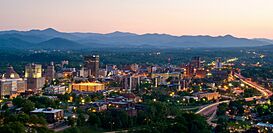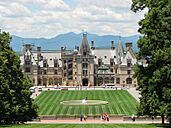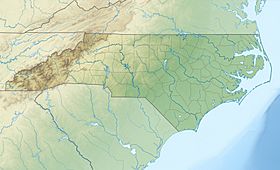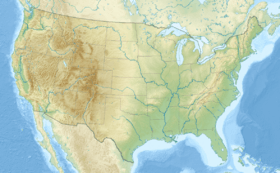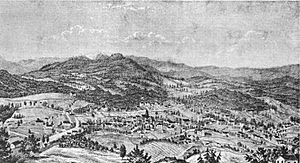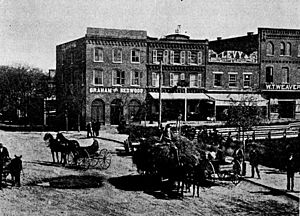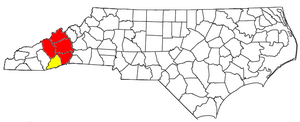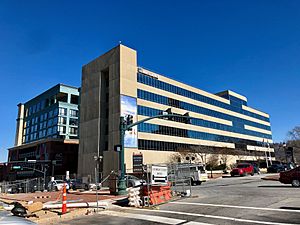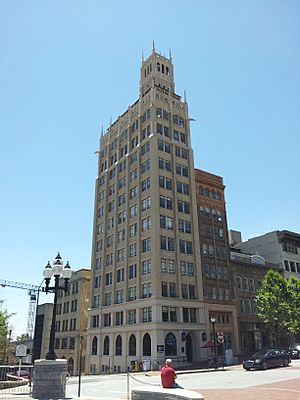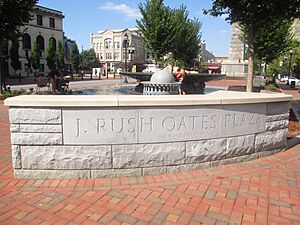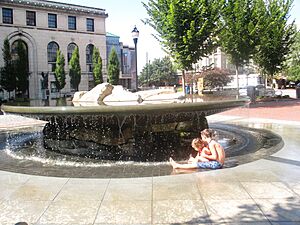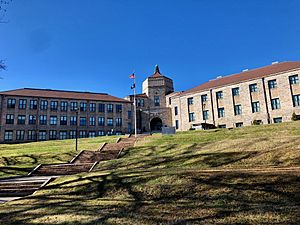Asheville, North Carolina facts for kids
Quick facts for kids
Asheville, North Carolina
|
|||||
|---|---|---|---|---|---|
|
|
|||||
|
|||||
| Nickname(s):
AVL, Land of the Sky
|
|||||
| Motto(s):
"Quality of Service, Quality of Life"
|
|||||
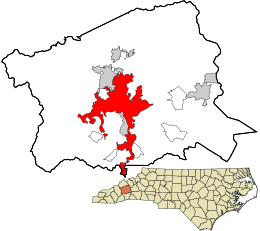
Location in Buncombe County and North Carolina
|
|||||
| Country | |||||
| State | |||||
| County | Buncombe | ||||
| Incorporated | 1797 | ||||
| Named for | Governor Samuel Ashe | ||||
| Government | |||||
| • Type | Council–manager | ||||
| • Body | Asheville City Council | ||||
| Area | |||||
| • Total | 45.86 sq mi (118.76 km2) | ||||
| • Land | 45.47 sq mi (117.77 km2) | ||||
| • Water | 0.39 sq mi (1.00 km2) 0.85% | ||||
| Elevation | 2,134 ft (650 m) | ||||
| Population
(2020)
|
|||||
| • Total | 94,589 | ||||
| • Estimate
(2023)
|
95,056 | ||||
| • Rank | 11th in North Carolina | ||||
| • Density | 2,080.20/sq mi (803.18/km2) | ||||
| • Urban | 285,776 (US: 141st) | ||||
| • Urban density | 1,149.6/sq mi (443.9/km2) | ||||
| • Metro | 417,202 (US: 131st) | ||||
| Demonym(s) | Ashevillan | ||||
| Time zone | UTC−5 (Eastern) | ||||
| • Summer (DST) | UTC−4 (EDT) | ||||
| ZIP Codes |
28801–28806, 28810, 28813–28816
|
||||
| Area code(s) | 828 | ||||
| FIPS code | 37-02140 | ||||
| GNIS feature ID | 1018864 | ||||
Asheville is a city in North Carolina, United States. It's the main city in Western North Carolina and the 11th largest in the state. Asheville is known for its beautiful mountain setting and its lively arts scene. The city is located where the French Broad and Swannanoa rivers meet. In 2020, about 94,589 people lived here. The larger Asheville area, including nearby counties, had an estimated population of 417,202 in 2023.
Contents
- Asheville's Past: A Look at History
- Asheville's Location and Weather
- Asheville's People and Culture
- Asheville's Economy
- Arts and Culture in Asheville
- Sports in Asheville
- Learning in Asheville
- Asheville's Media
- City Services and Transport
- Asheville's Sister Cities
- Notable People from Asheville
- Images for kids
- See also
Asheville's Past: A Look at History
How Asheville Started
Long ago, the land where Asheville is now was part of the Cherokee Nation. Spanish explorers visited in 1540, bringing diseases that sadly affected many native people. The Cherokee called this area "Where they race."
European settlers began to arrive in 1784 after the American Revolutionary War. One of the first settlers, Samuel Davidson, was killed by Cherokee hunters. His family and others later returned to settle the area.
By 1790, about 1,000 non-Cherokee people lived here. Buncombe County was formed in 1792. In 1797, a town called Morristown was renamed "Asheville" after North Carolina Governor Samuel Ashe.
Asheville During the Civil War
Around 1861, Asheville had about 2,500 people. The city was not directly involved in many battles during the American Civil War. However, it did send soldiers to both the Confederate States Army and the Union Army.
In April 1865, Union forces tried to take Asheville but met resistance. Later that month, Union troops captured the city. After the war, a man named George Avery, who had been enslaved, returned to Asheville. He managed the South Asheville Cemetery, which became the oldest and largest public cemetery for Black people in the state.
Growth and Change in the 1800s
A big change came to Asheville in 1880 when the first railroad line arrived. This helped the city grow a lot. Factories were built to make textiles, wood products, and other goods.
Asheville was also the first city in North Carolina to have electric street railways, which started in 1889. These were later replaced by buses in 1934.
Asheville in the 1900s
By 1900, Asheville was the third-largest city in North Carolina. It grew a lot in the 1910s and 1920s. However, the Great Depression in the 1930s hit Asheville very hard. Many banks failed, and the city had a lot of debt.
Because of this financial struggle, not many new buildings were constructed for a long time. This meant that many older buildings, especially those in the Art Deco style from the 1920s, were preserved. Today, Asheville has one of the best collections of Art Deco buildings in the United States.
In 1959, the Asheville Regional Airport was built. Passenger train service to Asheville ended in 1968. From the 1950s to the 1970s, many African-American residents were displaced from their homes due to urban renewal projects. Efforts are now being made to preserve places like the South Asheville Cemetery.
Asheville Today: 2000s and Beyond
In 2004, Asheville experienced major flooding from hurricanes. The city has also focused on important social issues. In 2020, the Asheville City Council voted to provide reparations to Black residents. This was to help address the city's past role in slavery and discrimination. The city is working to invest in areas where Black residents face challenges.
Asheville's Location and Weather
Asheville is located in the beautiful Blue Ridge Mountains. It sits where the Swannanoa River and the French Broad River meet. The city covers about 45.86 square miles. Most of this area is land, with a small part being water.
Asheville is about 100 miles northwest of Charlotte, North Carolina.
Asheville's Climate
Asheville has a climate that is a mix of humid subtropical and oceanic. This means it has warm summers and cool winters. Because it's in the mountains, Asheville's temperatures are cooler than cities farther east in North Carolina.
In July, the average temperature is about 75 degrees Fahrenheit. It rarely gets above 90 degrees. In January, the average temperature is around 37 degrees Fahrenheit. It doesn't often drop below zero degrees.
Asheville gets a good amount of rain throughout the year, averaging about 49.6 inches annually. Snowfall varies a lot each winter, averaging around 10.3 inches.
| Climate data for Asheville Regional Airport, North Carolina (1991–2020 normals, extremes 1876–present) | |||||||||||||
|---|---|---|---|---|---|---|---|---|---|---|---|---|---|
| Month | Jan | Feb | Mar | Apr | May | Jun | Jul | Aug | Sep | Oct | Nov | Dec | Year |
| Record high °F (°C) | 80 (27) |
80 (27) |
87 (31) |
90 (32) |
93 (34) |
98 (37) |
99 (37) |
100 (38) |
95 (35) |
91 (33) |
83 (28) |
81 (27) |
100 (38) |
| Mean maximum °F (°C) | 67.0 (19.4) |
69.3 (20.7) |
76.7 (24.8) |
82.5 (28.1) |
86.2 (30.1) |
89.4 (31.9) |
91.0 (32.8) |
90.1 (32.3) |
86.9 (30.5) |
81.3 (27.4) |
73.8 (23.2) |
66.9 (19.4) |
92.0 (33.3) |
| Mean daily maximum °F (°C) | 48.9 (9.4) |
52.9 (11.6) |
59.8 (15.4) |
69.4 (20.8) |
76.3 (24.6) |
82.5 (28.1) |
85.3 (29.6) |
84.0 (28.9) |
78.7 (25.9) |
69.6 (20.9) |
59.5 (15.3) |
51.5 (10.8) |
68.2 (20.1) |
| Daily mean °F (°C) | 38.7 (3.7) |
42.1 (5.6) |
48.4 (9.1) |
57.0 (13.9) |
64.8 (18.2) |
71.8 (22.1) |
75.1 (23.9) |
74.0 (23.3) |
68.3 (20.2) |
57.9 (14.4) |
47.8 (8.8) |
41.4 (5.2) |
57.3 (14.1) |
| Mean daily minimum °F (°C) | 28.6 (−1.9) |
31.2 (−0.4) |
37.0 (2.8) |
44.6 (7.0) |
53.2 (11.8) |
61.1 (16.2) |
64.9 (18.3) |
64.0 (17.8) |
57.9 (14.4) |
46.2 (7.9) |
36.1 (2.3) |
31.3 (−0.4) |
46.3 (7.9) |
| Mean minimum °F (°C) | 9.9 (−12.3) |
15.5 (−9.2) |
20.3 (−6.5) |
29.3 (−1.5) |
37.7 (3.2) |
49.4 (9.7) |
56.5 (13.6) |
54.5 (12.5) |
44.2 (6.8) |
30.0 (−1.1) |
21.6 (−5.8) |
16.3 (−8.7) |
7.6 (−13.6) |
| Record low °F (°C) | −16 (−27) |
−9 (−23) |
2 (−17) |
20 (−7) |
28 (−2) |
35 (2) |
44 (7) |
42 (6) |
30 (−1) |
20 (−7) |
1 (−17) |
−7 (−22) |
−16 (−27) |
| Average precipitation inches (mm) | 4.13 (105) |
3.46 (88) |
3.80 (97) |
4.17 (106) |
4.13 (105) |
4.79 (122) |
4.67 (119) |
5.04 (128) |
4.13 (105) |
3.37 (86) |
3.72 (94) |
4.18 (106) |
49.59 (1,260) |
| Average snowfall inches (cm) | 3.6 (9.1) |
1.9 (4.8) |
1.9 (4.8) |
0.2 (0.51) |
0.0 (0.0) |
0.0 (0.0) |
0.0 (0.0) |
0.0 (0.0) |
0.0 (0.0) |
0.0 (0.0) |
0.2 (0.51) |
2.5 (6.4) |
10.3 (26) |
| Average precipitation days (≥ 0.01 in) | 10.5 | 9.8 | 11.9 | 10.6 | 11.5 | 13.4 | 13.9 | 13.1 | 9.2 | 7.8 | 8.8 | 10.0 | 130.5 |
| Average snowy days (≥ 0.1 in) | 1.6 | 1.5 | 1.0 | 0.2 | 0.0 | 0.0 | 0.0 | 0.0 | 0.0 | 0.0 | 0.2 | 1.1 | 5.6 |
| Average relative humidity (%) | 72.6 | 69.8 | 68.4 | 66.2 | 75.3 | 78.6 | 81.6 | 83.5 | 84.1 | 78.4 | 74.8 | 74.1 | 75.7 |
| Average dew point °F (°C) | 26.1 (−3.3) |
27.1 (−2.7) |
34.7 (1.5) |
41.7 (5.4) |
52.9 (11.6) |
61.0 (16.1) |
65.3 (18.5) |
64.9 (18.3) |
59.4 (15.2) |
46.8 (8.2) |
37.6 (3.1) |
30.4 (−0.9) |
45.7 (7.6) |
| Mean monthly sunshine hours | 175.9 | 181.2 | 223.5 | 252.3 | 264.1 | 267.0 | 257.5 | 227.8 | 207.5 | 219.6 | 178.8 | 167.2 | 2,622.4 |
| Percent possible sunshine | 56 | 59 | 60 | 64 | 61 | 61 | 58 | 55 | 56 | 63 | 58 | 55 | 59 |
| Source: NOAA (relative humidity and dew point 1964–1990, sun 1961–1990) | |||||||||||||
Asheville's Neighborhoods
Asheville has many different neighborhoods. Some are in the north, like Montford and Grove Park, which are known for their historic homes. East Asheville includes areas like Kenilworth and Haw Creek. West Asheville has neighborhoods such as Burton Street and Emma. South Asheville includes Biltmore Village and Biltmore Park.
Asheville's Architecture
Asheville is famous for its unique buildings. Many downtown buildings are in the Art Deco style, like the Asheville City Hall. Other notable buildings include the Jackson Building, which was the first skyscraper in the area, and the Grove Arcade, one of America's first indoor shopping malls.
The Grove Park Inn is a great example of the Arts and Crafts movement style. Biltmore Village also has special architecture. The YMI Cultural Center is one of the oldest African-American cultural centers in the country.
Asheville's Metro Area
Asheville is the biggest city in the Asheville Metropolitan Statistical Area. This area includes Buncombe, Haywood, Henderson, and Madison counties. In 2023, this larger area had a population of about 513,720 people.
Asheville's People and Culture
Population Changes Over Time
| Historical population | |||
|---|---|---|---|
| Census | Pop. | %± | |
| 1800 | 38 | — | |
| 1850 | 502 | — | |
| 1870 | 1,400 | — | |
| 1880 | 2,616 | 86.9% | |
| 1890 | 10,235 | 291.2% | |
| 1900 | 14,694 | 43.6% | |
| 1910 | 18,762 | 27.7% | |
| 1920 | 28,504 | 51.9% | |
| 1930 | 50,193 | 76.1% | |
| 1940 | 51,310 | 2.2% | |
| 1950 | 53,000 | 3.3% | |
| 1960 | 60,192 | 13.6% | |
| 1970 | 57,929 | −3.8% | |
| 1980 | 54,022 | −6.7% | |
| 1990 | 61,607 | 14.0% | |
| 2000 | 68,889 | 11.8% | |
| 2010 | 83,393 | 21.1% | |
| 2020 | 94,589 | 13.4% | |
| 2023 (est.) | 95,056 | 14.0% | |
| U.S. Decennial Census | |||
Asheville's population has grown a lot over the years. In 1800, only 38 people lived here. By 2020, the population had grown to 94,589.
Who Lives in Asheville?
| Race / Ethnicity (NH = Non-Hispanic) | Pop 2000 | Pop 2010 | Pop 2020 | % 2000 | % 2010 | % 2020 |
|---|---|---|---|---|---|---|
| White alone (NH) | 52,340 | 63,508 | 70,252 | 75.98% | 76.16% | 74.27% |
| Black or African American alone (NH) | 12,054 | 11,024 | 9,752 | 17.50% | 13.22% | 10.31% |
| Native American or Alaska Native alone (NH) | 227 | 217 | 200 | 0.33% | 0.26% | 0.21% |
| Asian alone (NH) | 630 | 1,130 | 1,504 | 0.91% | 1.36% | 1.59% |
| Pacific Islander alone (NH) | 39 | 123 | 255 | 0.06% | 0.15% | 0.27% |
| Some Other Race alone (NH) | 108 | 160 | 654 | 0.16% | 0.19% | 0.69% |
| Mixed Race or Multi-Racial (NH) | 902 | 1,776 | 4,315 | 1.31% | 2.13% | 4.56% |
| Hispanic or Latino (any race) | 2,589 | 5,455 | 7,657 | 3.76% | 6.54% | 8.10% |
| Total | 68,889 | 83,393 | 94,589 | 100.00% | 100.00% | 100.00% |
As of the 2020 census, Asheville had 94,589 residents. The city is home to people from many different backgrounds. The East End/Valley Street area is the oldest and most important Black community in Asheville.
Places of Worship
Asheville has many different churches, including Baptist, Roman Catholic, Methodist, and Presbyterian. There are also non-Christian places of worship, like Urban Dharma, a Tibetan Buddhist center. The Basilica of St. Lawrence is an important church for Catholics in North Carolina.
Asheville's Economy
Asheville's economy relies a lot on tourism, especially because of places like the Biltmore Estate. Many people also work in creative jobs related to arts and culture. Some major companies based in Asheville include HomeTrust Bancshares and Ingles.
Top Employers in Asheville
Here are some of the largest employers in Asheville:
| # | Employer | # of employees |
|---|---|---|
| 1 | Mission Health System | 3,000+ |
| 2 | Buncombe County Schools System | 3,000+ |
| 3 | Ingles Markets, Inc. | 3,000+ |
| 4 | The Biltmore Company | 2,000+ |
| 5 | State of North Carolina | 1,000+ |
| 6 | Buncombe County | 1,000+ |
| 7 | Asheville VA Medical Center | 1,000+ |
| 8 | City of Asheville | 1,000+ |
| 9 | Wal-Mart | 1,000+ |
| 10 | Asheville–Buncombe Technical Community College | 1,000+ |
| 11 | Eaton | 1,000+ |
| 12 | Grove Park Inn | 500–999 |
| 13 | Asheville City Schools | 500–999 |
| 14 | Community CarePartners | 500–999 |
| 15 | United States Postal Service | 500–999 |
| 16 | BorgWarner Turbo Systems | 500–999 |
| 17 | Thermo Fisher Scientific | 500–999 |
| 18 | Arvato Digital Services | 500–999 |
| 19 | Employment Control | 500–999 |
| 20 | Volvo Construction Equipment (now closed) | 500–999 |
Being Green in Asheville
Asheville is working hard to be a "green" city. This means they try to protect the environment and use resources wisely. The city wants to reduce its carbon footprint by 80% by 2030. They have done things like installing LED street lights and improving building energy use. Asheville was also the first U.S. city to be recognized as a "Green Dining Destination" because of its many environmentally friendly restaurants.
Arts and Culture in Asheville
Music Scene
Asheville has a lively music scene. You can find live music in many places, and there are often festivals. "Shindig on the Green" is a popular event where local bluegrass bands play. The "Mountain Dance & Folk Festival" is one of the oldest folk festivals. "Downtown After 5" is another popular outdoor concert series. There's also a regular drum circle in Pritchard Park on Friday evenings.
Asheville is home to the headquarters of Moog Music, which makes electronic instruments. The city also has the Asheville Symphony Orchestra and many local bands. Famous bands like the Smashing Pumpkins and the Beastie Boys have played here.
Performing Arts
The Asheville Community Theatre was started in 1946. It's a place where local actors put on plays. The Asheville Lyric Opera performs professional operas for the community. The Fringe Arts Festival showcases unique and alternative performances.
Visual Arts
Asheville has many places to see art:
- The Asheville Art Museum shows different kinds of art. It reopened in 2019 after a big renovation.
- The Black Mountain College Museum + Arts Center teaches about the history of Black Mountain College.
- The River Arts District used to be an industrial area. Now, it's full of artist studios where you can see artists at work.
- The Southern Highland Craft Guild's Folk Art Center focuses on traditional crafts from the Appalachian region.
- The YMI Cultural Center displays art related to African-American heritage.
Film and TV in Asheville
Asheville has hosted several film festivals over the years. Currently, the city participates in the 48-Hour Film Project. Other events include Cat Fly Fest and the Twin Rivers Media Festival.
Delicious Food in Asheville
Asheville was the first U.S. city to be named a "Green Dining Destination" because of its many environmentally friendly restaurants. In 2022, two Asheville restaurants, Chai Pani and Cúrate, won special national awards for their food and hospitality.
Cool Places to Visit
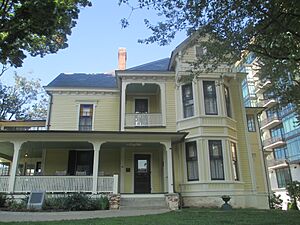
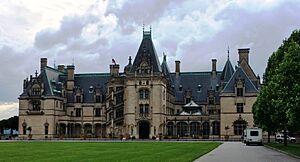
Asheville has many interesting places to visit:
- The Arras: The tallest building in Asheville.
- Biltmore Estate: The largest privately owned house in the United States. It's a famous historic landmark.
- Blue Ridge Parkway: A beautiful road known for its scenic views.
- Botanical Gardens at Asheville: Gardens where you can see many different plants.
- Grove Park Inn: A historic hotel known for its unique architecture.
- Jackson Building: The first skyscraper in western North Carolina.
- McCormick Field: One of the oldest baseball stadiums still in use for minor league games.
- North Carolina Arboretum: A large garden and research center.
- Smith-McDowell House: The oldest house in Buncombe County.
- Thomas Wolfe House: The childhood home of famous American author Thomas Wolfe.
Sports in Asheville
Asheville's Sports Teams
| Club | Sport | Founded | League | Venue |
|---|---|---|---|---|
| Asheville Tourists | Baseball | 1897 | South Atlantic League | McCormick Field |
| Asheville City SC | Soccer | 2016 | USL League Two | Memorial Stadium |
| Asheville City SC (Women's Team) | Soccer | 2017 | Women's Premier Soccer League | Memorial Stadium |
Past Teams
| Club | Sport | Founded | League | Venue | Years in Asheville |
|---|---|---|---|---|---|
| Asheville Smoke | Ice Hockey | 1991 | United Hockey League | Asheville Civic Center | 1998-2002 |
| Asheville Aces | Ice Hockey | 2004 | Southern Professional Hockey League | Asheville Civic Center | 2004-2005 |
| Asheville Altitude | Basketball | 2001 | National Basketball Developmental League | Asheville Civic Center | 2001-2005 |
Other Fun Sports
Colleges in the area, like the University of North Carolina at Asheville, have sports teams. Their teams are called the Bulldogs. Asheville is also a great place for whitewater kayaking. Many expert kayakers live here. You can also find many disc golf courses. Soccer is popular, with youth clubs and adult leagues. There's even an outdoor rink for inline hockey.
Learning in Asheville
Students in Asheville attend public schools run by either Buncombe County Schools or Asheville City Schools.
Public schools include Asheville High School and several middle and elementary schools. There are also private schools like Christ School and Asheville School.
Colleges in Asheville
Asheville has several colleges and universities:
- Asheville–Buncombe Technical Community College
- Lenoir–Rhyne University (Asheville campus)
- South College (Asheville campus)
- University of North Carolina at Asheville
Asheville's Media
Asheville has its own television stations, like WLOS Channel 13 (ABC). There are also many radio stations, including WCQS (public radio) and WSFM-LP (community radio).
The main daily newspaper is the Asheville Citizen-Times. The Mountain Xpress is a weekly paper covering arts and politics. There are also online news sources like Asheville Watchdog.
City Services and Transport
Getting Around Asheville
Asheville is served by the Asheville Regional Airport. Major highways like Interstate 40 and Interstate 26 pass through the city.
The city has a bus system called ART (Asheville Rides Transit). It has sixteen bus lines that travel throughout Asheville and to Black Mountain, North Carolina. There is no passenger train service in Asheville right now, but there are plans to bring it back.
Public Services
Asheville residents use the Buncombe County Public Libraries, which have 11 branches. The main library is Pack Memorial Library downtown. The city's water department provides drinking water. Sewer services are handled by the Metropolitan Sewerage District. Electricity comes from Duke Energy, and natural gas from PSNC Energy.
Asheville's Sister Cities
Asheville has "sister cities" around the world. These are cities that partner with Asheville to promote cultural understanding and friendship.
 Birnam, United Kingdom
Birnam, United Kingdom Dunkeld, United Kingdom
Dunkeld, United Kingdom Karpenisi, Greece
Karpenisi, Greece Osogbo, Nigeria
Osogbo, Nigeria San Cristóbal de las Casas, Mexico
San Cristóbal de las Casas, Mexico Saumur, France
Saumur, France Valladolid, Mexico
Valladolid, Mexico Vladikavkaz, Russia
Vladikavkaz, Russia
Notable People from Asheville
Many interesting people have come from Asheville, North Carolina.
Images for kids
See also
 In Spanish: Asheville para niños
In Spanish: Asheville para niños


